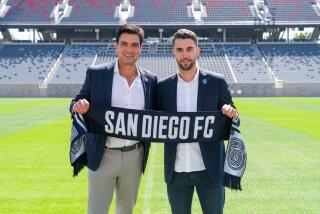New Team, New Hopes : The Heat Discovers L. A. Is a Cold, Cold Soccer Area
- Share via
Consider yourself a sports trivia master if you can name the professional outdoor soccer teams that have failed in Los Angeles in the last 20 years.
Here is a little hint: there are seven of them.
The now-defunct franchises, which included North American Soccer League and American Soccer League teams, were the L. A. Wolves, the L. A. Toros, the Aztecs, the Skyhawks, the California Surf, the California Sunshine and the Lazers.
Potential owners of soccer teams here seem to adhere to the adage, if at first you don’t succeed, try, try again: L. A. is at it again with two new outdoor soccer teams.
The Torrance-based L. A. Heat and the Hollywood Kickers joined Edmonton, Portland, Seattle, San Diego and San Jose in the fledgling Western Soccer Alliance for the league’s second season.
Keep Salaries Low
However, the game plan for success of attempts Nos. 8 and 9 is a complete reversal of the strategy employed by some of their predecessors.
The NASL, for example, relied on the big-name, expensive foreign player to attract fans. That plan worked initially. The New York Cosmos and its star Pele routinely drew crowds of 70,000 in the mid-1970s.
But the league eventually was crushed by the weight of the high salary its stars demanded.
Low-paid players, commanding about $1,200 a month, dominate the Heat and the other WSL teams’ rosters.
“The first problem with the NASL was that it brought in players and gave them too much money,” said L. A. Heat Coach Wim Suurbier, who played with Pele on the World Soccer team after leading the Dutch national team to the World Cup in 1974 and ’78.
“This league has to stay low budget. If we win, maybe we’ll get more money. But now, it’s like semipro.”
Relying on Locals
Suurbier said that it’s equally important to rely on mainly local, American players. In fact, of the 11 players on the field at any one time, 9 must be American, according to league rules.
“There’s enough good players around,” he said. “And it helps if the people have followed the players through high school and college and really know them.”
Mike Brady, a forward who led American University in Washington, D. C., to a runner-up finish to UCLA last season for the NCAA title, agreed with Suurbier.
“Hopefully, when people see the familiar names, it will generate interest,” said Brady.
The Heat’s local products include goalie David Vanole (Aviation High and UCLA), goalie Marine Cano (Bishop Montgomery High and El Camino College), defender Lou Sciappa (Hawthorne and Palos Verdes Highs) and the Ervine brothers, Glenn (North Torrance and El Camino) and Dale (North Torrance and UCLA).
Poor Attendance
However, the Heat has not ignited much interest. Michael Hogue, the team president, said that the average paid attendance at the Heat’s first six home games has been about 1,100. The Hollywood team reportedly has had similar attendance figures.
“I’m really not sure why it hasn’t taken off,” said Dale Ervine, a two-time All-American forward who led the Bruins past American University. “We’re all disappointed with the crowds we’re getting.”
Glenn Ervine said the crowds have been so small that it would take less time to introduce the people in the stands than the players.
“Seven teams have tried and seven teams have failed, so the percentages say you’re going to lose your ass,” Hogue said. “And although we’ve done fairly well at the gate compared to other teams in the league, we’re below our expectations.”
Not even the World Cup helped. In fact, Hogue said that as the cup picked up steam, which translates into increased interest and viewers, the Western Soccer Alliance lost fans.
Damaged by Past
The Heat plays its games on Saturdays and the weekend was the prime time to watch World Cup action, he said. Still, Hogue didn’t blame the World Cup for the lackluster support of his team. Instead, he pointed his finger to the past failures.
“When pro soccer was here, it alienated a lot of people,” he said. “So now, we’re paying for the sins of others.
“There was a base of support here at one time. The Surf and the Aztecs used to draw 3,000, 4,000 and even 5,000 a game. But that base has disappeared, and we have to rebuild it.”
Suurbier, a native of Amsterdam, argues that the fundamental problem has been and is that American leagues lack organizational foundation. For one thing, he said that friction exists between the amateur and professional ranks.
“In Europe, you start playing when you’re 10,” he said. “If you’re good enough, you play professionally. If you’re not, you play amateur soccer. But you can play both.
“Here, if you play pro, you can’t play in college. That’s a big disadvantage. You can learn so much from both sides.”
Game Conflicts Hurt
He added that in Europe no league games ever would be scheduled in conflict with a national team game. But in the U. S., a player often must choose between league and national games.
For example, Dale Ervine, David Vanole and Tim Schulz all were invited to the U. S. Olympic Festival July 25-Aug. 3 in Houston. Ervine played in the Heat’s July 26 game in San Diego by leaving Houston early in the morning and returning immediately after the game. Still, all three will miss the Aug. 2 game against Seattle.
“It’s unfair to the fans because then they’re seeing teams that aren’t at their best,” Suurbier said. “And even if it doesn’t affect my team, but it affects the other team, it hurts soccer in general.”
And that’s something the American leagues can ill afford. After all, Suurbier said his European friends find the state of soccer in the U. S. amusing.
“They don’t believe we have to pump up our balls, or set up our own goals and have to struggle for fields,” he said. “They think it’s silly and wonder how I coach here.”
Miserable Field
His friends aren’t amused by the Heat’s practice facility; they’re appalled.
The field at Mira Costa High, which has but one goal, is studded with holes and other hazards. During a recent practice, Manny Neves, a midfielder, after receiving a pass, came to abrupt stop--with no defender between him and the goal--so that he could step over a gully.
Of course, the practice field isn’t keeping fans away. Winning is the key to increasing the activity at the gate for any sports franchise.
Despite its 2-2-5 record, Brady said the Heat can be a big winner. As proof, he cites a 3-0 loss to the Scotland World Cup team May 30, in which the Scots scored twice on penalty kicks, and “we missed a penalty kick and some other scoring opportunities.”
But then goals have been far and few between for the Heat. The team has scored only 11 goals, which includes four in one game, a 4-1 win against Portland.
Looking Ahead
“I’m more interested in developing than looking for results,” Coach Suurbier said.
“Don’t get me wrong. I want to win, and the team wants to win. But I have to figure out what I can do with each player. We have to start with nothing and build slowly. You just can’t expect miracles.”
Some soccer experts contend that teams devoid of foreign players, who they deem possess greater skill, will need miracles to win at a professional level. But Glenn Ervine, a member of the U. S. Olympic team from 1982-84, rejects that.
“That was true maybe 10 or 15 years ago,” said Ervine, who rejected an offer to play professionally in Glasgow last November. “Your average player from Britain isn’t any more special than your average American player.”
Brady, the Adidas and Soccer America’s college player of the year in 1985, said that the sport’s successful tradition in Europe gives the foreign player an advantage over his American counterpart.
Few Stars to Watch
“The greatest advantage the foreign player has is that he can watch top-notch players every week,” Brady said. “A coach can tell you what to do, but we can watch other people do those things and then go out and practice them for ourselves.
“Apart from actually playing, that’s the best way to learn. And Americans have no one to watch.”
And if support doesn’t come soon, outdoor soccer fans in L. A. again will have no one to watch.
“We’d just be another soccer team that bit the dust,” Glenn Ervine said.
More to Read
Go beyond the scoreboard
Get the latest on L.A.'s teams in the daily Sports Report newsletter.
You may occasionally receive promotional content from the Los Angeles Times.










